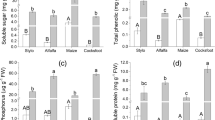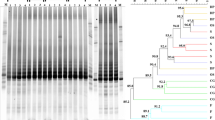Abstract
The colonization of leaves of the aquatic macrophyteCeratophyllum demersum L. by epiphytic bacteria, and the hypothesis that bacterial invasion causes leaf senescence, was studied using transmission and scanning electron microscopy and light microscopy. Population densities of epiphytic bacterial communities onCeratophyllum leaves were positively correlated with leaf age. Initial settlement of bacteria on young leaves appeared to favour the boundaries between epidermal cells. On older leaves, large populations of bacteria were present over the whole surface. One third of senescentCeratophyllum leaves examined by transmission electron microscopy showed signs of bacterial invasion. Of these, up to 54% of the leaf's epidermal cells contained bacteria. Areas of cell wall degradation were associated with invasive bacteria in senescent leaves. In healthy, nonsenescent leaves, no bacterial invasion was observed. These results suggest that epiphytic bacteria did not cause leaf senescence but probably colonized the internal tissues of leaves once senescence had occurred.
Similar content being viewed by others
References
Allanson BR (1973) The fine structure of the periphyton ofChara sp. andPotomageton natans from Wytham Pond, Oxford, and its significance to the macrophyte-periphyton metabolic model of R.G. Wetzel and H.L. Allen. Freshw Biol 3:535–542
Arber A (1963) Water plants, a study in aquatic angiosperms. Pub. J. Cramer, Weinheim. Wheldon and Welsley Ltd, Codicote
Baker JH (1984) Factors affecting the bacterial colonization of various surfaces in a river. Can J Microbiol 30:511–515
Baker JH (1988) Epiphytic Bacteria. In: Austin B (ed) Methods in aquatic bacteriology. John Wiley and Sons, London
Baker JH, Farr IS (1977) Origins, characterization, and dynamics of suspended bacteria in two chalk streams. Arch Hydrobiol 80:308–326
Baker JH, Farr IS (1987) Importance of dissolved organic matter produced by duckweed (Lemna minor) in a Southern English river, Freshw Biol 17:325–330
Baker JH, Orr DR (1986) Distribution of epiphytic bacteria on freshwater plants. J Ecol 74:155–165
Bastardo H (1979) Laboratory studies on decomposition of littoral plants. Pol Arch Hydrobiol 26:267–299
Best EPH (1979) Ecophysiological studies on growth and development of the aquatic macrophyteCeratophyllum demersum. Drukkerij Elinkwijk BV, Utrecht
Benner R, Peele ER, Hodson RE (1986) Microbial utilization of dissolved organic matter from leaves of the red mangrove,Rhizophora mangle, in the fresh creek estuary, Bahamas. Est Coast Shelf Sci 23:607–619
Brown SD, Austin AP (1973) Spatial and temporal variations in periphyton and physicochemical conditions in the littoral of a lake. Arch Hydrobiol 71:183–232
Costerton JW, Geesey GG, Cheng K-J (1978) How bacteria stick, Sci Am 238:86–95
Denny P (1980) Solute movement in submerged angiosperms. Biol Rev 55:65–92
Findlay SEG, Arsuffi TL (1989) Microbial growth and detritus transformations during decomposition of leaf litter in a stream. Freshw Biol 21:261–269
Geesey GG, Costerton JW (1979) Microbiology of a Northern River: Bacterial distribution and relationship to suspended sediment and organic carbon. Can J Microbiol 25:1058–1062
Hossell JC, Baker JH (1979a) A note on the enumeration of epiphytic bacteria by microscopic methods with particular reference to two freshwater plants. J Appl Bact 46:87–92
Hossell JC, Baker JH (1979b) Estimation of the growth rates of epiphytic bacteria andLemna minor in a river. Freshw Biol 9:319–327
Hossell JC, Baker JH (1979c) Epiphytic bacteria of the freshwater plantRanunculus penicillatus: Enumeration, distribution, and identification. Arch Hydrobiol 86:322–337
Howard-Williams C, Davies BR, Cross RHM (1978) The influence of periphyton on the surface structure of aPotomageton pectinatus L. leaf (a hypothesis). Aquat Bot 5:87–91
Jordan TL, Staley JT (1976) Electron microscopic study of succession in the periphyton community of Lake Washington. Microb Ecol 2:241–251
Moran MA, Hodson RE (1989) Bacterial secondary production on vascular plant detritus: Relationships to detritus composition and degradation rate. Appl Environ Microbiol 55:2178–2189
Noodén LR (1980) Senescence in the whole plant. In: Thimann KV (ed) Senescence in plants. CRC Press, Florida
Paterson DM, Wright SJL (1986) The epiphyllous algal colonization ofElodea canadensis Michx: Community structure and development. New Phytol 103:809–819
Rimes CA, Goulder R (1985) A note on the attachment rate of suspended bacteria to submerged plants in a calcareous stream, J Appl Bact 59:389–392
Roemer SC, Hoagland KD, Rosowski JR (1984) Development of a freshwater periphyton community as influenced by diatom mucilages. Can J Bot 62:1799–1813
Rogers KH, Breen CM (1981) Effects of epiphyton onPotomageton crispus L. leaves. Microb Ecol 7:351–363
Rogers KH, Breen CM (1983) An investigation of macrophyte epiphyte, and grazer interactions. In: Wetzel RG (ed) Periphyton of freshwater ecosystems. Development in Hydrobiology, No. 17, Dr. W. Junk, The Hague
Salisbury FB, Ross CW (1978) Plant physiology. Wadsworth Publishing Comp, Belmont, CA
Sand-Jensen K, Søndergaard M (1981) Phytoplankton and epiphyte development and their shading effect on submerged macrophytes in lakes of different nutrient status. Internal Rev der Gesam Hydrobiol 66:529–552
Silvester NR, Sleigh MA (1985) The forces on microorganisms at surfaces in flowing water. Freshw Biol 15:433–448
Thimann KV (1980) The senescence of leaves. In: Thimann KV (ed) Senescence in plants. CRC Press, Florida
Underwood GJC, Thomas JD (1990) Grazing interactions between pulmonate snails and epiphytic algae and bacteria. Freshw Biol 19:505–522
Wetzel RG, Manny BA (1972) Secretion of dissolved organic carbon and nitrogen by aquatic macrophytes. Verh Int Ver Limnol 18:162–170
Zuberer DA (1984) Microbial colonization of some duckweeds (Lemnacea): Examination by scanning and transmission electron and light microscopy. Aquat Bot 18:275–285
Author information
Authors and Affiliations
Rights and permissions
About this article
Cite this article
Underwood, G.J.C. Note: Colonization and invasion of leaves of the aquatic macrophyteCeratophyllum demersum L. by epiphytic bacteria. Microb Ecol 21, 267–275 (1991). https://doi.org/10.1007/BF02539158
Received:
Revised:
Issue Date:
DOI: https://doi.org/10.1007/BF02539158




